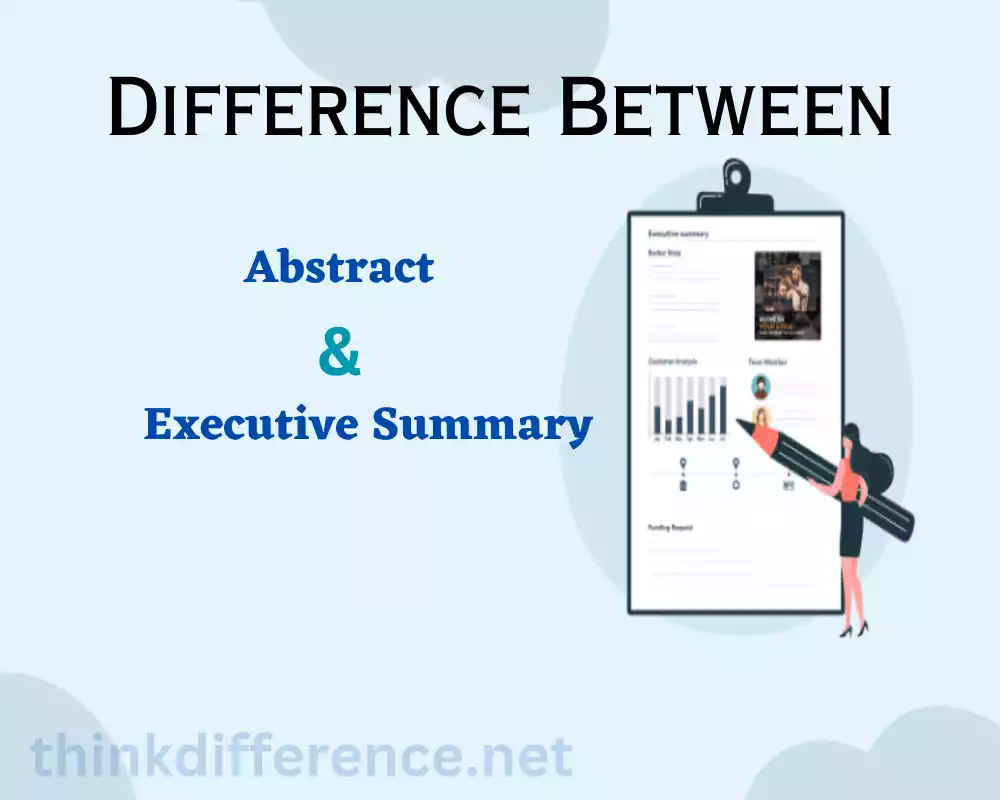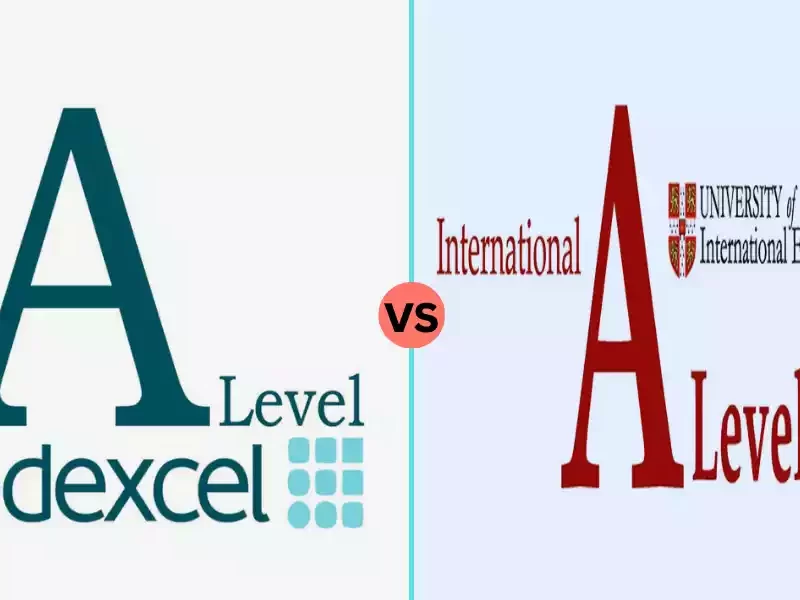Abstract and Executive Summary are short versions of lengthy documents, providing readers with an overview of its main aspects and conclusions. Executive summaries and abstracts are frequently employed for scientific papers, academic research reports, business proposals and proposals, among many other applications. Although both serve the same objective, there are distinct distinctions between executive summaries and abstracts.
What is an Abstract?
Abstracts are brief summaries of larger documents like research papers or articles. Usually written as stand-in pieces that summarize major aspects, findings, and conclusions found within them, abstracts serve to help readers quickly grasp basic ideas without needing to read all the words on a page at once.
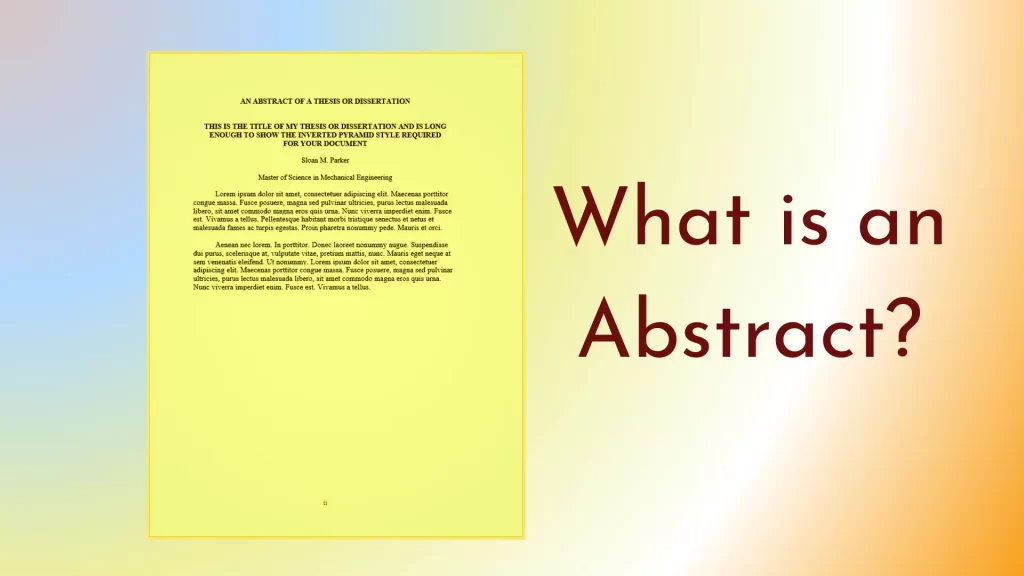
Abstracts provide readers with an overview of a text’s contents that relates to their research or interests requirements. Abstracts are frequently employed at conferences, academic journals and databases as a tool to assist users decide if they wish to read through its entirety or bypass it entirely.
Abstracts should be written using clear and plain language that provides enough detail about key aspects in the text without using too many technical terms or providing too much unnecessary detail. Their length varies according to both publication requirements as well as content needs but usually falls somewhere within one or multiple paragraphs.
Abstracts allow users to quickly assess the meaning and content of writing pieces to see if they meet their requirements or needs.
Characteristics of an Effective Abstract
An effective abstract possesses several key characteristics that enable it to fulfill its purpose of providing a concise summary of a document. Some of the important characteristics of an effective abstract are:
-
- Accuracy: An effective abstract accurately represents the content and main points of the document it summarizes. It should reflect the key findings, conclusions and arguments presented in the original work without distortion or misrepresentation.
- Clarity and Readability: The abstract should be written in clear and accessible language that can be easily understood by the target audience. It should avoid unnecessary jargon, complex terminology or overly technical details that may hinder comprehension.
- Conciseness: An effective abstract is succinct and to the point. It focuses on conveying the essential information while omitting excessive details, examples or background information that are not critical to understanding the main content.
- Structure: A well-structured abstract follows a logical and organized format. It typically includes sections such as the purpose/objective, methodology, key findings/results, and conclusions/recommendations. This structure helps readers quickly navigate and comprehend the main components of the document.
- Completeness: While being concise, an effective abstract should still provide a comprehensive overview of the document. It should cover all the significant aspects and main points, including the scope, approach, main findings and conclusions. It does not need to include every minor detail or supporting evidence.
- Objectivity: An effective abstract maintains an objective and unbiased tone. It presents the document’s content without personal opinions, biases or subjective interpretations. The abstract should provide a factual summary that allows readers to form their own judgments about the document.
- Standalone Capability: The abstract should be able to stand alone as a self-contained summary. It should provide sufficient information for readers to understand the main content and significance of the document, even if they do not have access to the full text.
- Appropriateness to Audience: An effective abstract considers the target audience and their specific needs. It highlights the aspects of the document that are most relevant and interesting to the intended readers, ensuring that they can quickly determine if the document aligns with their interests or research goals.
By embodying these characteristics, an abstract can effectively serve as a concise representation of a document, enabling readers to determine its relevance and decide whether to explore the full text further.
What is an Executive Summary?
An executive summary is an abbreviated form of a larger report or proposal document that highlights key components and advice, in an easy to comprehend structure. An executive summation may be written for stakeholders, decision makers or professionals who don’t have time or desire to read through all its pages but still require knowledge about its contents.
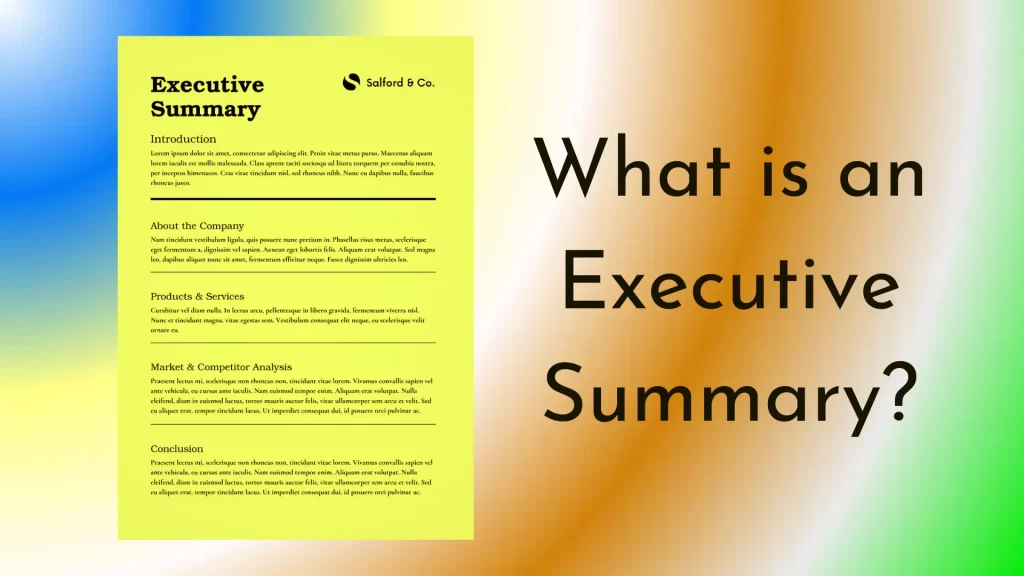
An executive overview aims to give readers an accessible summary of a document, quickly conveying its significance, findings, and recommendations. As an effective communication tool for busy executives or decision makers to access all necessary information efficiently.
Executive summaries provide an overview of a document. In these summaries, typically only key chapters or sections in a report are addressed. This section may address an issue or problem being examined, purpose for creating it, method employed to collect results or draw conclusions and main results/recommendations that follow from it. Its amount of detail depends on document length/complexity but it must contain enough specifics that present primary elements clearly.
Contrasting abstracts which tend to be written as independent documents, an executive summary usually forms part of an overall document itself and should appear immediately following its table of content (after tables and before introduction), before entering its main body (body). According to its length and depth of detail needed, an executive summary could range anywhere between just several paragraphs and multiple pages long.
An effective executive summary requires being organized, well-written and stand alone from its sources of documents. It should convey primary contents in an accessible fashion so readers may easily comprehend its purpose, major points, guidelines or policies. It must consider both its intended audience as well as employ relevant language that caters for their level of understanding or knowledge.
Executive summaries play an essential role in providing decision makers and others with an overview of documents so that they may make educated choices or take appropriate actions based on that summation information.
Components of an Effective Executive Summary
An effective executive summary should include several key components to provide a comprehensive overview of a document.
These components typically include:
- Introduction:
- Provide a brief introduction to the document’s purpose and background.
- Clearly state the problem or issue being addressed and its significance.
- Set the context for the information that follows.
- Objectives:
- Clearly state the objectives or goals of the document.
- Outline what the document aims to achieve or the questions it seeks to answer.
- Specify the scope and boundaries of the document’s focus.
- Methodology:
- Briefly describe the research or investigative methods employed, if applicable.
- Highlight the approach taken to gather data, conduct analysis or reach conclusions.
- Provide a brief outline of how conclusions were reached for this report.
- Key Findings:
- Summarize the most important and relevant findings from the document.
- Highlight significant data, statistics or evidence supporting the findings.
- Findings should be presented clearly and simply for maximum impact.
- Conclusions:
- Outline the main conclusions drawn from the document’s findings.
- Emphasize the implications or significance of the conclusions.
- Address any limitations or uncertainties associated with the conclusions.
- Recommendations:
- Present actionable recommendations based on the document’s findings and conclusions.
- Provide clear and specific suggestions for future actions or decisions.
- Explain how the recommendations align with the document’s objectives and address the problem or issue at hand.
- Impact or Benefits:
- Discuss the potential impact or benefits that can be achieved by implementing the recommendations.
- Highlight the positive outcomes or improvements that can result from following the suggested actions.
- Maintain a clear understanding of the value and significance of the content for those you aim to reach.
- Executive Summary Length:
- Consider the length of the executive summary, ensuring it is concise but comprehensive.
- Strike a balance between providing enough detail for understanding and keeping it succinct.
- Tailor the length to the specific document, following any guidelines or requirements provided.
Remember that an effective executive summary should accurately represent the main content and key points of the document, providing decision-makers and stakeholders with a clear understanding of its significance and recommendations. Your executive summary must be well-structured, written in simple language and read as an informative document without having to refer back.
Importance of Abstract and Executive Summary in documents
Abstracts and executive summaries serve a key function within documents by offering concise summaries of principal details and important aspects.
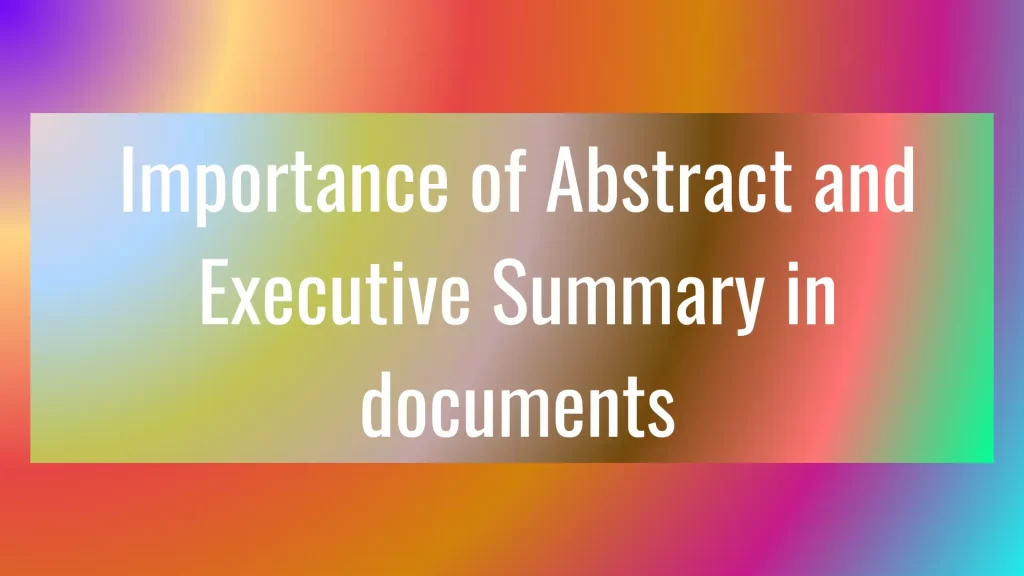
Here are just a few reasons why Abstracts/executive summaries could prove valuable:
Time-Saving: Abstracts and executive summaries allow readers to quickly assess the relevance and importance of a document without having to read the entire text. Decision-makers, stakeholders or busy professionals can efficiently gather essential information and make informed decisions based on the summarized content.
- Accessibility: Abstracts and executive summaries make documents more accessible to a wider audience. Assumptions provide an accessible overview that makes complex documents simpler to comprehend for those without time, knowledge or interest in diving deeper. Abstracts and executive summaries cater to different readers with varying levels of interest and expertise.
- Decision-Making Support: Executive summaries are specifically targeted at decision-makers and stakeholders. By presenting the main findings, conclusions and recommendations, executive summaries provide the necessary information for these individuals to make informed decisions or take appropriate actions based on the summarized content.
- Research and Academic Relevance: Abstracts are particularly important in research and academic settings. Researchers use research presentations as a means of sharing their goals, methodologies, findings, results and achievements of their work to the academic community. Abstracts help researchers determine the relevance of a study and decide whether to read the full paper.
- Database Indexing and Searching: Abstracts are commonly used in databases and indexing services. They enable efficient searching and retrieval of relevant documents based on keywords, topics or subject areas. Abstracts provide researchers with a quick glimpse of a document’s contents, making it easy for them to quickly locate relevant material.
- Communication and Collaboration: Abstracts and executive summaries facilitate effective communication and collaboration among professionals, researchers and stakeholders. They serve as a common language to convey the main points and significance of a document, allowing for effective information sharing and collaboration across different fields and disciplines.
- Marketing and Promotion: Abstracts and executive summaries also serve a marketing and promotional purpose. In conferences, journals or business proposals, abstracts and executive summaries are often the first elements that potential readers encounter. Engaging and informative summaries can attract attention, generate interest and encourage readers to explore the full document.
Abstracts and executive summaries are important components of documents as they provide concise overviews of the main content, save time for readers, facilitate decision-making, enhance accessibility and support effective communication and collaboration. They serve as gateways to the full document, enabling readers to quickly grasp its significance, relevance and main points.
Differences Between Abstracts and Executive Summaries
Abstracts and executive summaries both serve the same function providing a concise outline of documents.
There are some key differences between them that should be kept in mind:
- Placement and Length:
- Abstracts: Abstracts are typically positioned at the beginning of a document, after the title and before the introduction. These essays tend to be shorter in length usually consisting of only one paragraph or several short paragraphs.
- Executive Summary: Executive summaries are usually located within the document itself, placed after the table of contents and before the main body or introduction. These papers tend to be longer than abstracts and could range anywhere between several paragraphs and multiple pages depending on the extent and complexity of their texts.
- Content and Focus:
- Abstracts: Abstracts primarily focus on summarizing the content of the document. They provide a concise overview of the document’s purpose, methodology, main findings and conclusions. Abstracts are written with an audience in mind, typically those without time or the desire to read an entire document in detail.
- Executive Summary: Executive summaries cover not only the content but also the main sections or chapters of the document. They highlight the key elements, main points, conclusions and recommendations. Executive summaries are often written for decision-makers, stakeholders or busy professionals who require a comprehensive understanding of the document’s significance and main findings.
- Target Audience:
- Abstracts: Abstracts are intended for a broader audience. They aim to provide a quick overview for readers who may be conducting preliminary research, seeking specific information or determining whether the document aligns with their interests.
- Executive Summary: Executive summaries are primarily aimed at decision-makers, stakeholders or busy professionals who need to make informed choices based on the summarized information. They provide a concise summary that allows these individuals to quickly grasp the document’s main points and make decisions without reading the full report.
- Writing Style:
- Abstracts: Abstracts emphasize brevity and conciseness. They use clear language and avoid excessive technical jargon to ensure accessibility for a wide range of readers.
- Executive Summary: While still concise, executive summaries may include more details and technical terms relevant to the target audience. They strike a balance between providing a comprehensive overview and being easily understandable for decision-makers and professionals.
Abstracts and executive summaries serve distinct purposes and cater to different audiences. Abstracts focus on summarizing the content for a broader audience, whereas executive summaries provide a comprehensive overview for decision-makers and professionals. They differ in terms of placement, length, content coverage, target audience and writing style.
Tips for Writing an Engaging Abstract and Executive Summary
Writing an engaging abstract and executive summary is essential to captivate readers and convey the main points effectively.
Here are some tips for crafting engaging abstracts and executive summaries:
- Clearly state the purpose: Start off by clearly outlining the purpose of the document in an engaging way. Clearly communicate what the document aims to achieve or the problem it addresses.
- Identify the key findings and conclusions: Highlight the most important findings, conclusions or recommendations in a compelling manner. Make sure that the main points that readers need in order to comprehend what this document contains.
- Use concise and clear language: Keep the language of the abstract and executive summary straightforward and easy to understand. Avoid excessive technical jargon or complex terminology that may confuse or alienate readers. Be concise and use simple, yet precise, language to convey the main points effectively.
- Structure the content logically: Organize the content of the abstract and executive summary in a logical and coherent manner. Follow a clear structure that allows readers to easily navigate the information. Use headings or subheadings if applicable to provide a clear outline of the main sections covered.
- Capture attention with a compelling opening: Begin the abstract or executive summary with a compelling opening sentence or paragraph that grabs the reader’s attention. Use powerful language, intriguing statements or impactful statistics to pique their interest and encourage further reading.
- Highlight the benefits or implications: Clearly communicate the benefits, implications or impact of the document’s findings or recommendations. Explain why the content is relevant and valuable to the readers. Emphasize how the document can contribute to solving a problem or achieving desired outcomes.
- Tailor to the target audience: Consider the specific needs and interests of the target audience when writing the abstract or executive summary. Adapt the language, level of detail and focus to align with their expectations and priorities. Use language and terminology appropriate for the intended readers.
- Proofread and edit carefully: Ensure that the abstract and executive summary are free from grammatical errors, typos or inconsistencies. Be mindful of both the clarity and flow of language when speaking or writing. Edit and revise the content to improve its readability and impact.
- Review and revise for conciseness: Strive for conciseness in the abstract and executive summary by eliminating unnecessary details or repetitive information. Focus on conveying the essential points in a concise manner without sacrificing clarity or understanding.
- Seek feedback: Before finalizing the abstract and executive summary, seek feedback from colleagues, peers or experts in the field. Their input can help identify areas for improvement, ensure clarity and enhance the engagement of the content.
By applying these tips, you can create abstracts and executive summaries that effectively engage readers, convey the main points and leave a lasting impression.
Conclusion
The Abstract and Executive summary are invaluable tools that condense extensive information into easily digestible formats. They play distinct roles, with the abstract serving academic and research purposes, while the executive summary aids decision-making in the business realm. Crafting an exceptional abstract and executive summary requires a thoughtful approach, focusing on relevance, clarity, and brevity.
Boost your efficiency in navigating through complex documents and making informed choices by mastering the art of creating compelling abstracts and executive summaries.

